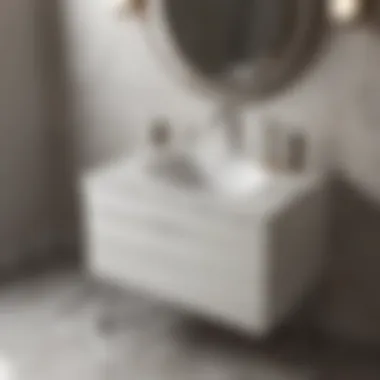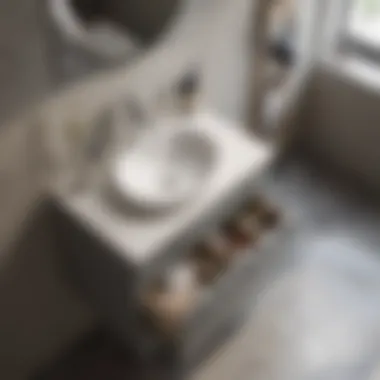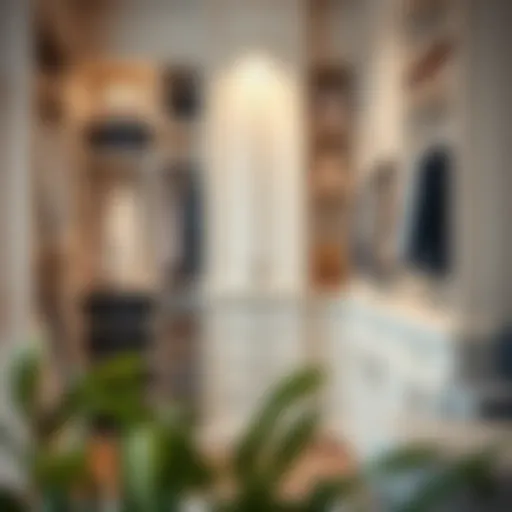Affordable Vanities with Tops: Style Meets Budget


Intro
When it comes to transforming a space, few elements carry as much weight as vanities with tops. These fixtures can serve not just as functional necessities but also as show-stopping focal points in bathrooms and other areas throughout the home. However, with so many options available, discerning which vanities provide the perfect balance between cost, style, and functionality can prove to be a daunting task.
In this guide, we aim to break down the essentials of affordable vanities. From understanding the latest design trends to knowing how to care for your chosen pieces, our exploration will provide valuable insights tailored for homeowners, designers, and DIY enthusiasts alike.
Furniture Styles and Trends
Modern vs. Traditional: Understanding the Aesthetics
The first step in choosing the right vanity with a top is to understand the difference between modern and traditional styles. Modern vanities tend to embrace clean lines and minimalistic designs, often utilizing materials like glass, metal, and engineered wood. They might come in bold colors, such as deep navy or crisp white, aiming to evoke a contemporary feel.
On the flip side, traditional vanities exude warmth and character, often incorporating rich woods and classic shapes. Think of ornate details and softer colors like muted whites and earth tones. These vanities tend to blend seamlessly with old-world charm and can become a cherished part of your home.
Color and Material Trends: What's In and What's Out
Keeping pace with current trends is essential when selecting a vanity. Recently, there has been a noticeable shift towards sustainable materials. Bamboo and reclaimed wood are making waves, catering to a growing audience that prioritizes eco-friendly choices. Additionally, natural stone tops, like granite and quartz, continue to be in vogue, offering durability and style.
However, darker colors have started to take a back seat, making way for lighter shades. Pale greens, soft blues, and warm whites dominate newer collections.
To summarize, here are a few things to keep in mind when considering trends:
- Eco-friendly Materials: Bamboo and reclaimed wood are popular.
- Color Choices: Lighter shades are favored over dark hues.
- Natural Stone Tops: Granite and quartz are still on the rise.
"Choosing the right vanity is not just about aesthetics; it's about finding harmony between function and form."
Furniture Care and Maintenance
Tips for Prolonging the Life of Your Furniture
Investing in a vanity is a long-term commitment, and maintaining it properly is crucial for longevity. Here are some practical tips:
- Dust Regularly: Build-up can lead to scratches.
- Use Gentle Cleaners: Avoid harsh chemicals that can damage surfaces.
- Seal Stone Tops: If you choose a natural stone, sealing it regularly will help prevent stains.
DIY Repair Hacks for Common Furniture Issues
Every piece of furniture may encounter wear and tear over time. Knowing a few DIY hacks can save you both time and money.
- Scratches: Use a marker that matches the wood to touch up minor scratches.
- Water Rings: Mix equal parts olive oil and vinegar, apply gently, then buff and polish.
- Wobbly Legs: Tighten screws or use furniture coasters to stabilize.
By following these recommendations, you'll ensure your chosen vanity not only serves its purpose but also remains an appealing addition to your home for many years to come.
Understanding Cheap Vanities with Tops
In today’s home decor landscape, cheap vanities with tops play a significant role. These pieces not only enhance the aesthetic appeal of a bathroom or vanity area but also offer functionality without breaking the bank. Understanding this topic is essential for anyone considering a remodel or upgrade on a budget. It’s about recognizing the wide variety of options available that can fit both style preferences and utility needs.
Defining Cheap Vanities
Cheap vanities, simplified, are bathroom furniture that provide storage and surface area but come with a lower price tag. They might be less extravagant compared to high-end counterparts but do not skimp on style or practicality. Generally, these vanities can be found in many forms, ranging from modern minimalistic designs to classic looks that evoke a sense of tradition. The primary definition moves beyond just the cost; it also involves understanding craftsmanship, materials, and a unique charm that these pieces can offer.
Importance of Vanity Tops
While the base of the vanity is crucial, the top often makes the first impression. Vanity tops are the finishing touch that brings the entire piece together. They come in various materials, from granite to quartz, and serve both functional and decorative purposes. A durable top can withstand daily use, while its design can either blend in with the home decor or become a striking focal point.
Moreover, having the right vanity top can greatly influence the overall maintenance of the space. For example, a quartz top is often easier to clean and more resistant to stains compared to laminate. It's essential to think about how these decisions affect long-term satisfaction with your selection.
"Choosing a vanity with a suitable top is much like picking the right hat. It can make or break the whole outfit."
In summary, understanding cheap vanities with tops leads to informed decisions that prioritize both style and practicality. It’s about striking a balance between aesthetics and affordability, ensuring that the final selection meets not just immediate needs but also long-term expectations.
Materials Used in Budget Vanities
When it comes to creating a stylish yet affordable vanity, the materials used play a vital role. Not only do they affect the price, but they also influence the durability, aesthetics, and functionality of the unit. A thorough understanding of various materials helps homeowners make wise choices that align with their design preferences and budget constraints. Each material brings its own set of qualities that could either elevate the overall look or fall short on performance.
Popular Materials: Pros and Cons
Wood
Wood is undoubtedly a classic choice for many vanities, and its natural warmth can create an inviting atmosphere. One specific aspect of wood is its versatility; it can conform to a variety of styles from traditional to modern. The key characteristic that makes wood a beloved option is its aesthetic appeal. It can be stained or painted to fit into any decor scheme, making it a beneficial selection for those who like to change things up often.
However, wood is not without its drawbacks. It’s often prone to warping or scratching, especially in humid environments, which could lead to costly repairs. Another thing to consider is that solid wood vanities may stretch the budget a bit more than other materials.
Laminate
Laminate is a popular budget option due to its affordability and versatility. It can imitate the look of more expensive materials, like wood or stone, making it an attractive choice for those on a tight budget. Laminate is particularly beneficial because it’s resistant to stains and easy to clean.
On the flip side, laminate can chip or peel over time, especially at the edges where it’s most vulnerable. It also doesn’t offer the same durability as solid wood or other premium materials, which can be a turn-off for long-term use.
MDF
Medium-Density Fiberboard, or MDF, offers a compelling blend of affordability and adaptability. It’s typically denser than regular particle board, which makes it a sturdy choice for vanities that might undergo daily wear and tear. What’s striking about MDF is its smooth surface, which takes paint well and allows for a sleek, uniform appearance.
But, it’s worth noting that MDF has its limitations when it comes to exposure to moisture. Over time, water can seep in and cause the material to swell or degrade, making it less suitable for humid areas unless properly sealed.
Metal
Metalvanities are making a striking comeback in contemporary designs. This material is both modern and durable, offering a unique aesthetic that can add an industrial edge to a bathroom or dressing area. The key characteristic of metal is its resistance to decay, making it a long-lasting option for homeowners.
However, metal surfaces can be cold to the touch and may not provide the warmth that other materials do. Additionally, while metal is sturdy, an untreated surface might be susceptible to scratches and dents.
Top Surface Options
Granite
Granite is a luxurious option that screams elegance, but it can still fit into a budget if you do your homework. It’s known for its durability and resistance to scratches and heat. A unique feature of granite is its natural variations, meaning each slab is one-of-a-kind. This adds a personal touch to your vanity, making it a delightful investment.


However, granite does require regular sealing to maintain its look and prevent stains, which can be a downside for some homeowners.
Quartz
Quartz is an engineered stone that combines natural minerals with resin, making it both durable and available in a wide range of colors. One of its most significant benefits is the low maintenance—no sealing is required, and it's non-porous.
On the downside, quartz can be more expensive than granite, and it may not have the same organic feel that some homeowners prefer. Moreover, it can be sensitive to heat if placed directly without care.
Glass
Using glass as a top surface might not be for everyone, but it sure does offer a sleek and sophisticated look. Glass can give the illusion of more space and light, making even small areas feel more open. An appealing feature is that glass is easy to clean and resists stains and odors.
However, the downside is its fragility; untempered glass can be easily scratched and may not withstand heavy impacts. If you choose glass, make sure it's designed for durability.
Solid Surface
Solid surface materials like Corian present a non-porous, easy-to-maintain surface that mimics the look and feel of natural stone but without the hefty price tag. This choice is excellent for those who want a seamless look because it can be molded to fit any shape. Moreover, it offers a myriad of colors and patterns to fit various design preferences.
But be aware that solid surface materials can scratch or dent, requiring a level of extra care. They may not withstand scorching heat either, so caution is necessary in high-traffic areas.
While considering materials for budget vanities, it’s wise to remember that each choice comes with its own set of advantages and pitfalls. Weighing these factors can lead to a well-rounded selection that matches both your needs and your budget.
Styles of Affordable Vanities
When it comes to affordable vanities, style plays a pivotal role. It's not just about practicality or price; the style can dramatically influence the overall aesthetics of a space. Selecting the right vanity can set the tone for your bathroom or powder room. This section will explore various styles of vanities, such as traditional, modern, and rustic, emphasizing their unique features and what they bring to the table.
Traditional Vanities
Traditional vanities often evoke a sense of timeless elegance. They generally feature intricate designs, carved woodwork, and rich finishes. Such vanities may resemble furniture more than bathroom fixtures, acting as statement pieces within your home.
Features to Consider:
- Materials: Typically crafted from solid wood or wood veneer, ensuring durability and classic appeal.
- Design Elements: Look for details like turned legs, crown moldings, and raised panel doors. These are the hallmarks of a traditional style.
- Color Palette: Warm, muted hues like mahogany, oak, or cherry contribute to a cozy environment.
Traditional vanities not only offer functionality but also radiate sophistication, making them ideal for homeowners who appreciate classic design principles.
Modern and Contemporary Styles
In contrast to the intricacy found in traditional styles, modern and contemporary vanities emphasize clean lines, minimalism, and functionality. The focus here is more on the sleekness and utility of the piece rather than on embellishment.
Key Characteristics:
- Materials: Often use engineered materials like laminate or MDF, which can be finished in high-gloss or matte options.
- Color Choices: Neutral tones, such as whites, grays, and blacks, dominate, helping to maintain an uncluttered look.
- Design Syntax: Features like wall-mounted vanities or floating styles uphold space-saving solutions, particularly in smaller bathrooms.
The modern vanity often suits those who prefer a streamlined appearance, emphasizing simplicity without sacrificing quality.
Rustic and Farmhouse-Inspired Designs
Rustic and farmhouse designs are stepping into the limelight, reflecting a yearning for natural textures and a connection to nature. These styles prioritize functionality while incorporating elements that evoke a sense of warmth and nostalgia.
Essentials to Note:
- Materials: Wood is the star here, especially reclaimed or distressed types, that tell a story through their imperfections.
- Design Aesthetic: Look for open shelving, barn doors, or vintage hardware. Such details infuse charm and encourage practicality.
- Color Schemes: Soft whites, warm greys, and earthy tones help create an inviting ambiance.
Overall, rustic vanities create a homey feel and often enhance the natural beauty of bathrooms, making them a popular choice for those looking to add character.
Ultimately, selecting a vanity style is about personal preference and how it complements your space. Make sure to consider both aesthetics and function when making your choice!
Functionality vs. Aesthetics
When it comes to choosing vanities for your home, one cannot overlook the delicate balance between functionality and aesthetics. This is especially true when we talk about affordable vanities with tops. While style catches the eye, usability keeps the household in rhythm. Finding that sweet spot where both aspects meet can be a bit tricky but certainly worth the effort.
The essence of functionality lies in how well a vanity serves everyday needs without compromising on style. For instance, a vanity that looks stellar but lacks adequate storage is like a beautiful frame that holds nothing but empty air. It's essential to assess features like drawer capacity, space for toiletries, or even ease of cleaning. Functionality ensures that a vanity is not just a pretty face but an integral part of your daily routine.
Aesthetics, on the other hand, represent the personality of your spaces. The colors, designs, and finishes add that zing to a typically mundane area like a bathroom. A stunning vanity can transform an area, making it feel more inviting and alive. However, as tempting as it might be to go for the latest trend or eye-catching design, neglecting functionality can lead to regret down the line.
In short, it’s about assessing your lifestyle and environment. Swapping practicality for beauty may leave you, quite frankly, in a tight spot where the vanity looks great but just doesn’t work with what you’ve got. Achieving harmony between these two elements, however, can lead not just to satisfaction but a space that truly reflects who you are.
Balancing Form and Utility
Striking a balance between form and utility in cheap vanities isn’t just a nicety—it's a necessity. This is about more than just deciding how the vanity looks; it's about how it functions within the context of your life.
Consider the design of the vanity. A chic, modern piece may appeal to your elegant side, but if it doesn’t offer enough counter space or storage, it could end up being more of a hindrance than a help. Evaluate your expectations. If you have a small bathroom, large vanities may clutter rather than enhance. Hence, function ought to play a big contributor when making your choice.
Moreover, utility doesn’t have to come at the cost of aesthetics. There are plenty of vanities designed with innovative features that also please the eyes. Perhaps it’s a shiny quartz top combined with a sleek cabinet, or a rustic wooden structure that offers tons of storage options, it’s about how these elements can work together.
Storage Solutions in Cheap Vanities
Having ample storage is crucial to keep your areas organized. Let's examine popular storage solutions often featured in budget-friendly vanities.
Drawers
Drawers serve as the unsung heroes of vanity space. They offer the ability to keep your essentials tucked away yet easily accessible. Many modern and affordable vanities come with deep or divided drawers that help categorize items like skincare products, tools, and daily necessities. The key characteristic of drawers is their versatility, as they can be used in both small and large spaces. Their unique feature of being closable means that they conceal clutter, enhancing visual appeal. However, a disadvantage can be that drawers require sufficient space to pull out completely, which may not be feasible in cramped areas.
Cabinets
Cabinets also play an important role in maximizing storage. Unlike drawers, cabinets provide open shelves that can store larger items like towels and extra toiletries. What makes cabinets a beneficial choice is their capacity to house various items visibly, yet the potential drawback is that they may not always allow for organized storage unless paired with bins or baskets.
Open Shelving
Open shelving is an increasingly popular design choice, particularly in modern and eclectic spaces. This type of storage solution encourages showcasing decorative items and easy access to daily essentials. It can create an airy feel, making a small area appear more spacious. The unique feature of open shelving is its ability to be rearranged virtually anytime, allowing for added creativity. Nevertheless, the downside is that it requires regular tidying up since items are always visible, which may not suit everyone's lifestyle, particularly in a busy household.
Balancing aesthetics and functionality in vanities may feel like walking a tightrope, but identifying your needs will place you firmly on the ground.
Choosing the Right Vanity for Your Space
Selecting the right vanity requires a careful consideration of not just aesthetics but also functionality and space optimization. A vanity does more than just add to the decor; it serves a crucial role in daily life. It’s where you start your day, preparing for whatever might come next. Choosing wisely ensures you aren’t just picking a pretty piece but investing in a fixture that truly meets your needs.


One must consider several elements before making a decision:
- Available Space: Is your bathroom spacious or a tad cramped? Knowing the dimensions can help tailor your choice.
- Personal Needs: Do you need extra drawers for storage? Or perhaps your focus is on a sleek look with minimal clutter?
- Style Preference: Modern, traditional, farmhouse—each style speaks a different language.
In essence, picking the right vanity for your space is about marrying form and function without compromising on your unique style.
Assessing Your Needs and Space
Before diving into the ocean of vanity options, first take a step back and assess what you genuinely need. Consider how many people will be using the vanity and what storage solutions will serve you best. Think about the arrangement of your bathroom as well—does the layout promote efficiency?
- Usage Frequency: A shared bathroom may require more space and drawers than a private one.
- Personal Items: If you have an extensive collection of skincare products or makeup, consider a vanity with greater surface area and storage.
- Aesthetics vs. Utility: Does a rich mahogany finish draw you in? Or do you prefer a simple, clean white finish? Finding balance here is crucial.
Once you’ve nailed down functionality, visualize how the vanity will fit into your space. Take a moment to jot down your wants versus needs.
Measuring for Sizing Accuracy
Measurements may seem tedious, yet they're the backbone of a successful vanity selection. An ill-fitting vanity can lead to a string of problems down the line, including complications during installation or an awkward aesthetic. Here’s how to go about it:
- Measure Width, Height, and Depth: Use a style often employed by carpenters, starting from the floor up to the ceiling, and then the width from wall to wall. Sketch it out if need be.
- Consider Door and Drawer Opens: Make sure to measure how much room is needed for doors and drawers to open freely.
- Leave Breathing Space: Allow for some room on either side to create an inviting look. Tight quarters tend to feel cramped.
"An accurate measure is worth a thousand guesses." This philosophy certainly holds when it comes to buying a vanity.
In essence, measuring properly not only avoids purchasing mishaps but also enhances the overall visual coherence of the space. Taking one’s time at this stage can save a world of trouble later on.
Installation and Maintenance of Vanities
When it comes to a new vanity, selecting one is just half the battle. Installation and maintenance are equally, if not more, crucial elements that can greatly impact the longevity and satisfaction of your vanity investment. Without proper installation, even the most beautiful vanity could end up being a disaster, while adequate maintenance ensures that it remains visually appealing and fully functional for years to come. Understanding these aspects not only saves you headaches but also contributes significantly to the overall value of your home. So, let's dig into the essentials!
Installation Considerations
Installing a vanity isn't exactly rocket science, but taking shortcuts can lead to more trouble down the line. Before diving in, here are some key notes to mull over:
- Space Assessment: First off, gauge the dimensions of your vanity and the allocated space. There’s nothing worse than realizing the new piece doesn’t fit!
- Plumbing and Electrical Needs: Don't forget about where the water connections and electrical outlets are. If your new vanity comes with a sink or light features, it might require different plumbing or electrical jobs.
- Proper Leveling: A vanity that isn’t level can lead to water pooling on one side. Use a level tool during installation to avoid future issues.
- Wall-Mounted vs. Freestanding: If your choice is a wall-mounted vanity, confirm the weight limits and make sure you’re utilizing wall studs for secure mounting.
- Secure Fixtures: Ensure all screws and connectors are tightened properly to prevent wobbling. Trust me, a loose vanity can be a recipe for disaster.
Taking the time to factor in these basics makes the whole installation process smoother and helps keep your vanity where it belongs—standing proud in your space.
Routine Maintenance Tips
We all know that an ounce of prevention is worth a pound of cure. Regular maintenance of your vanity isn’t just about keeping it looking sharp; it also extends its lifespan. Here are some practical tips that won’t tie you up in knots:
- Cleaning: Use a gentle cleanser and soft cloth for regular wipe-downs. Harsh chemicals can damage the finish, so steer clear of them. A vinegar solution can do wonders in lightening up stubborn stains.
- Check for Damage: Every few months, inspect for scratches, dents, or any water damage. Early detection can save you a lot of trouble later.
- Tighten Hardware: Periodically check knobs, handles, and hinges to make sure everything stays snug as a bug. A loose handle can lead to bigger problems.
- Avoid Excess Water: Excess moisture can warp wood materials over time. Make sure to wipe up any spills promptly, and consider using coasters under personal items.
- Re-sealing Surfaces: For materials like granite and quartz, you might need to re-seal surfaces every couple of years to maintain their integrity and sheen.
Regular maintenance ensures your vanity not only looks good but also functions well over time. Investments made today in care can save you bigger expenses later.
Cost Implications
Navigating the waters of acquiring inexpensive vanities with tops necessitates a firm grasp of cost implications. This topic deserves attention as it directly influences decisions made by homeowners, designers, and DIY enthusiasts. When it comes to budget-friendly choices, being aware of expenses can prevent both financial strain and shopping remorse.
Understanding the overall costs involved—from purchase price to installation and maintenance—can ultimately determine the longevity of the vanity and the satisfaction it brings. Buying a cheaper vanity may seem appealing upfront. However, it is vital to scrutinize long-term costs associated with it, such as durability and upkeep. With that said, here are some essential facets to consider:
- Purchase Price: The initial amount invested must align with expectations for quality and design. Finding a low-cost vanity doesn’t mean sacrificing style. Homeowners should balance aesthetics with an eye on their wallets.
- Installation Costs: Sometimes, opting for a not-so-expensive vanity can lead to unexpected installation fees. A complicated install process can inflate costs. Even a seemingly simple unit may demand more work if modifications are needed.
- Maintenance and Durability: Cheaper materials can wear out faster, leading to repair or replacement costs. In the long run, investing slightly more initially can yield savings by avoiding repairs.
"A sound budget marries dreams with reality, ultimately leading to foolproof choices."
Incorporating these assessments into the buying process will pave the way for wise choices and sustain financial health.
Setting a Realistic Budget
Creating a balanced budget is not just about knowing how much money one has available. It involves a careful evaluation of various factors that contribute to total expenditure fairly. To develop a realistic budget, consider the following steps:
- Research Prices: Scour both online and local marketplaces to establish a baseline cost for the type of vanity and top desired. This helps avoid being blindsided by exorbitant prices.
- Include All Costs: Factor in delivery, disposal of old vanities, and potential repair services if needed.
- Prioritize Needs vs. Wants: Determine what is essential for the space versus what is merely desirable is crucial. This distinction can help allocate funds wisely.
Value for Money Analysis
A value for money analysis ensures that each penny spent is justified through quality, durability, and functionality. This part evaluates what one receives in return for their investment rather than solely focusing on the price tag. Here are some aspects to consider:
- Quality Assessment: Assessing the materials used in the vanity can be telling. For instance, a laminate finish may appear appealing at first glance, yet may not stand the test of time as solid wood or metal does.
- Functionality vs. Cost: Does the vanity serve its purpose well? Sometimes splurging a little on a feature-packed model benefits overall functionality.
- Warranty and Return Policy: A solid warranty can be a safety net that adds value. Knowing one has the option to return or replace unsatisfactory models is a comfort.
Ultimately, understanding cost implications combined with a realistic budgeting strategy can streamline the buying process and lead to decisions that truly enhance home spaces while remaining practical.
Sustainability in Vanity Choices
In today's world, where environmental awareness weaves through our daily lives, the choices we make for our homes heavily reflect our values and priorities. When it comes to selecting affordable vanities with tops, sustainability isn't just a buzzword; it’s becoming an essential consideration for many homeowners and designers. Opting for sustainable vanities can lead to a product that not only meets functionality but also contributes positively to the planet. This section delves into specific elements, benefits, and considerations surrounding sustainability in vanity choices.
The Role of Eco-Friendly Materials
When we think about eco-friendly materials, the first step is to consider what makes up those materials. Vanities that prioritize sustainability can often be created from reclaimed wood, bamboo, or plywood made from sustainable sources. These materials not only reduce waste but also decrease the energy needed to manufacture new products. Using materials that are low in volatile organic compounds (VOCs) is crucial. VOCs can off-gas harmful fumes, polluting indoor air, which makes choosing low-VOC finishes and adhesives a wise decision.
In addition, such materials often boast durability that exceeds that of their less eco-friendly counterparts. For example, bamboo is known for its strength and resilience, making it a great option for vanities subject to wear and tear, which is common in high-traffic areas like bathrooms.
"Sustainability in our living spaces reflects our commitment to preserving the natural world for future generations."
Long-Term Value of Sustainable Options
Investing in sustainable vanities often translates to long-term savings and benefits. While the upfront cost may seem higher, the durability associated with quality eco-friendly products leads to fewer repairs and replacements over time. Choosing a vanity made from solid hardwood or treated bamboo does not just reflect an eco-conscious mindset but also a practical one; these materials can withstand the test of time, providing immense value for your money in the long run.
Furthermore, there’s a noticeable trend among consumers who prefer products that tell a story. A vanity crafted from reclaimed wood might not only add character to your space but also serves as a conversation starter, enhancing the aesthetic of your home. It’s more than just functionality—it's about enriching the experience of living in a space that feels unique and thoughtfully constructed.
As the market moves forward, being mindful of sustainability will likely become a standard expectation, and those who embrace it now may find themselves ahead of the curve. Making sustainable choices now means you’ll not only be ready for the future trends but also promote a lifestyle that respects the resources of our planet.
Current Trends in Vanity Designs
Keeping up with current trends in vanity designs can be likened to knowing what’s hot in the fashion world; it’s essential for homeowners and designers alike. Not only do the latest trends reflect changing tastes, they also influence the overall vibe of a space. Today’s vanities aren’t just pieces of furniture or functional items in the bathroom—they reflect the personality of a home and can enhance its overall aesthetic.
Color and Finishing Trends
When color comes into play, the stakes are high. Minimalism has become a popular choice, with crisp whites and soft cream tones dominating the scene. This palette allows vanities to blend effortlessly with any decor. Yet, there’s a palpable shift towards bolder choices too—rich navy blues, deep greens, or even striking matte blacks breathe life into spaces, showcasing a homeowner’s personal flair.


- Two-tone designs are making waves as well. Picture a classic white vanity with a natural wood top or a deep navy body complemented by brass hardware. Not only does this method add dimension, but it also ushes depth into spaces that might otherwise feel flat.
- Natural finishes are increasingly sought after. Rustic vanities, featuring textured wood grains finished with a protective coating, bring warmth and authenticity to modern homes while still keeping an air of sophistication.
Emerging Features and Technologies
The best part about current trends is the intersection of design and technology. The rise of smart homes has inevitably influenced vanity designs. Here are some noteworthy features reshaping expectations:
- Integrated lighting is hotter than a summer’s day. Built-in LED lighting frames mirrors perfectly while also enhancing functionality, providing excellent visibility for daily routines.
- Sensor-operated faucets have popped up on the market, catering to those who prefer a savvy setup that boasts cleanliness and convenience. Picture that—no need for touch points when washing hands.
- Smart mirrors that incorporate Bluetooth for music or lighting options have turned the mundane act of looking in the mirror into an interactive experience. These innovations ensure that vanities aren’t just furniture but also central hubs of activity in the home.
Investing in standout trends transforms mundane spaces into marvelous realms of personal expression.
Shopping for Cheap Vanities
When embarking on the journey of renovating or upgrading your home, selecting a vanity can often feel like navigating a minefield. The term "cheap" is often misunderstood, but here, it embodies affordability merged with quality. Shopping for cheap vanities is not merely about finding something that fits within a budget, but more about uncovering the treasure trove of stylish, functional, and financially sensible options available. This section will illuminate the multiple avenues to explore when seeking these affordable gems that beautify bathrooms and enhance functionality at the same time.
Where to Find Affordable Options
Online Retailers
Online retailers have become a go-to source for many homeowners and designers seeking budget-friendly vanities. The primary advantage of shopping online lies in the vast selection available at your fingertips. With a few keystrokes, you can compare dozens of styles, materials, and prices without setting foot outside your door.
The standout feature of online shopping is the convenience; you can peruse customer reviews, view detailed product images, and often find better deals than in physical stores. Platforms like Wayfair or Home Depot frequently offer discounts, further sweetening the deal. However, a word of caution: the inability to physically inspect a product before purchasing can sometimes lead to disappointment if the vanity doesn’t meet expectations upon arrival.
Local Stores
Local stores present a different shopping experience that can be equally rewarding. While the selection may not match the sheer volume of online retailers, local shops often feature hand-picked collections that reflect the trends and tastes of your community. This can be a unique journey through various options, touching and seeing what you might choose for your space.
An important aspect of buying from a local store is the personalized customer service you often receive. Knowledgeable staff can guide you through your choices, offering insights on what might work best in terms of size and style. However, keep in mind that prices at local stores can sometimes be steeper than online, so it's wise to compare before making a commitment.
Thrift Shops
Don’t overlook thrift shops, the unsung heroes in the world of budget-friendly home furnishing. These establishments can yield stunning finds and often hold hidden treasures just waiting to be appreciated again. The charm of a thrift shop is its unpredictability; one visit may unveil a vintage vanity that tells a story, while another could turn up a modern piece at a fraction of the cost elsewhere.
Thrift stores usually have the best prices in town, but the challenge lies in availability and condition. It's not uncommon to come across slightly worn pieces that need a touch of TLC. However, for DIY enthusiasts, these imperfections can be an opportunity for a creative makeover. Be prepared to hunt, as your perfect match may not always be in stock.
Evaluating Online Reviews
When shopping online, the importance of evaluating customer reviews cannot be understated. Reviews provide potential buyers with a fairly accurate representation of product performance, quality, and seller reliability. Looking for patterns in the feedback can give insights into common issues or highlights that may influence your decision.
Highlight Important Insights
Conduct your searches with keywords reflecting your needs and desires. A review that mentions durability and ease of installation can be golden nuggets of wisdom. Conversely, be wary of products receiving consistently poor ratings for sturdiness or difficulty in assembly. Trustworthy sites like Reddit or Facebook groups dedicated to home improvement often provide relatable advice based on real-life experiences.
Case Studies of successful Vanity Installations
Examining case studies of vanity installations sheds light on the diversity of designs and how they perform in real-world settings. It offers a hands-on glimpse into the decision-making process that homeowners and designers navigate when selecting affordable vanities and tops. These real-life examples can provide valuable lessons and insights that are applicable when embarking on similar projects.
Real-Life Examples
One notable installation involves a small bathroom renovation in a mid-century home. The homeowner opted for a charming, white shaker-style vanity with a granite top. This design choice was not only aesthetically pleasing but also practical. The white finish helped brighten the compact space, while the durable granite surface provided an elegant touch without breaking the bank. Moreover, it featured a set of drawers beneath the sink, which maximized storage potential in a bathroom that often suffered from limited space.
In contrast, another example is set in a contemporary loft space where the owners chose a sleek, espresso-finished vanity paired with a solid surface top. This choice aligned with their modern design aesthetic and offered a striking contrast against the light-colored walls. The open shelving below the vanity provided a unique decorative opportunity, allowing them to display plants and decorative baskets while keeping essential items accessible.
Lessons Learned from Each Installation
From these installations, several lessons emerge:
- Assessing Space Limitations: The first project underscores the necessity of understanding room size and layout. A vanity needs to harmonize with existing features while providing essential functionality. Homeowners learned to prioritize vertical storage solutions like drawers instead of bulky cabinets.
- Material Choice Impacts Functionality: In both cases, the material of the tops significantly influenced longevity and ease of maintenance. The granite in the first example proved resistant to staining, while the solid surface in the loft offered seamless integration and easy clean-up, teaching a vital lesson about functionality over mere appearance.
- Aligning with Personal Style: Ultimately, these case studies illustrate how important it is to choose a vanity that not only fits the space but also reflects the homeowner's style. Each example, despite being rooted in different aesthetics, emphasizes that personal preference should always guide design choices. A vanity shouldn’t just serve a purpose; it should feel like an integral part of the home’s story.
"The true measure of a successful installation lies in how well the vanity complements the existing decor while delivering on practical needs."
By delving into actual installations, potential buyers gain a clearer picture of what is achievable within their budget. Understanding both the successes and challenges faced by others can inform decisions that lead to satisfying results.
Potential Pitfalls of Cheap Vanities
When it comes to home improvement, choosing the right vanity might not seem like a daunting task at first glance. However, navigating through the world of affordable options demands an awareness of potential pitfalls that can lead to buyer's remorse. In this section, we will explore not only the common mistakes made when selecting cheap vanities but also how to sidestep the trap of settling for poor-quality products. The aim is to ensure that readers are equipped with the insights needed to make informed decisions and end up with a vanity that meets expectations in terms of quality and functionality.
Common Mistakes in Selection
When diving into the array of budget-friendly vanities available, it’s easy to get swept away by the allure of low prices. However, some common mistakes may catch you off guard:
- Ignoring Measurements: One of the biggest blunders is neglecting to check if the size fits the space. You may find yourself in possession of a fantastic vanity, only to realize it’s too large or small for your room.
- Focusing Solely on Cost: While affordability is key, prioritizing price over quality can lead to regrettable buys. A vanity that breaks down after a few months isn't worth the money saved upfront.
- Overlooking Warranty and Return Policies: Buying without considering the manufacturer's warranty can backfire. A solid warranty protects your investment. If it’s flimsy, maybe reconsider.
- Not Paying Attention to Reviews: Failing to read online reviews is another frequent oversight. Existing customers often share valuable insights that could highlight shortcomings you might encounter.
Taking the time to carefully consider these factors can often mean the difference between satisfaction and frustration down the line.
How to Avoid Poor Quality Products
To navigate the minefield of low-priced offerings, there are steps buyers can take to ensure they’re not stuck with subpar items:
- Research Brands: Not all brands take the same approach to quality. Look into those that have a reputation for delivering value.
- Check for Sturdiness: Assess the build quality, especially hinges and drawer slides. Cheap materials may result in instability.
- Request Samples: If possible, ask to see material samples. This way, you get a feel for what you’re actually purchasing.
- Avoid Surprise Charges: Ensure you understand the total cost, including delivery and assembly if necessary, to avoid a price balloon.
- Consult with Experts: Don't hesitate to reach out to professionals in the field; their expertise could provide insights that save you from costly mistakes.
In sum, understanding the potential pitfalls of cheap vanities not only guards your pocketbook but also enhances your satisfaction with your chosen pieces. Being informed allows you to buy with confidence, ensuring that the vanity you choose will not only serve its purpose but also elevate the aesthetics of your space.
The Future of Vanity Designs
The landscape of bathroom vanities is rapidly evolving, reflecting broader trends in personal taste and sustainability. In this era, understanding the trends and innovations shaping vanity designs is paramount for homeowners, designers, and retailers alike. The future of these beloved fixtures isn't merely about aesthetics; it encompasses functionality, eco-friendliness, customization, and technology integration. Keeping abreast of these shifts can lead to better investment decisions and designs that align with personal and environmental values.
Predictions Based on Current Patterns
Several patterns in consumer preferences and market dynamics indicate possible trajectories for vanity designs going forward. Here are key points articulated through recent trends:
- Minimalism remains a strong preference. The clutter reduction philosophy leads to streamlined designs that maximize utility without overwhelming spaces.
- Sustainable materials are gaining traction. More shoppers are leaning towards options that are not just affordable but also environmentally sound, emphasizing longevity and recyclability.
- Smart features are on the rise. As technology integrates further into daily living, expect to see vanities equipped with LED lights, built-in charging stations, and even voice-activated storage solutions.
Such trends reveal the growing desire among consumers for aesthetics aligned with practicality. From the sleek lines of contemporary styles to the rich textures of reclaimed materials, the future is decidedly bright for budget-friendly vanities that do not skimp on quality or innovation.
Innovations on the Horizon
As we peek into what’s next for vanity designs, several innovations promise to shake things up significantly.
- 3D Printing Technology: Imagine customizing your vanity down to the last detail—from size to style. 3D printing is poised to take personalization to a whole new level, enabling designers to create bespoke pieces that fit unique spaces perfectly.
- Smart Home Integration: With technology continually encroaching on our daily routines, expect more vanities that sync with home systems. This could involve anything from syncing lighting preferences for ambiance to integration with personal assistants that help organize toiletries or schedules.
- Flexible Designs: The need for adaptability will guide innovations. Vanities that can expand or contract based on user needs, or those that can transition from a single-user space to a shared facility easily, are projected to become more common.
"The future of vanity designs is not only about reflecting current tastes but also about embracing the innovations that deliver on functionality and sustainability for a smarter home."
In summary, the trajectory of vanity designs indicates a future that values minimalism, sustainability, and technological integration, all while remaining stylish and functional. For homeowners and designers keen on staying ahead of the curve, keeping an eye on these trends can assist in making well-informed choices that are practical, stylish, and aligned with the values of tomorrow.















